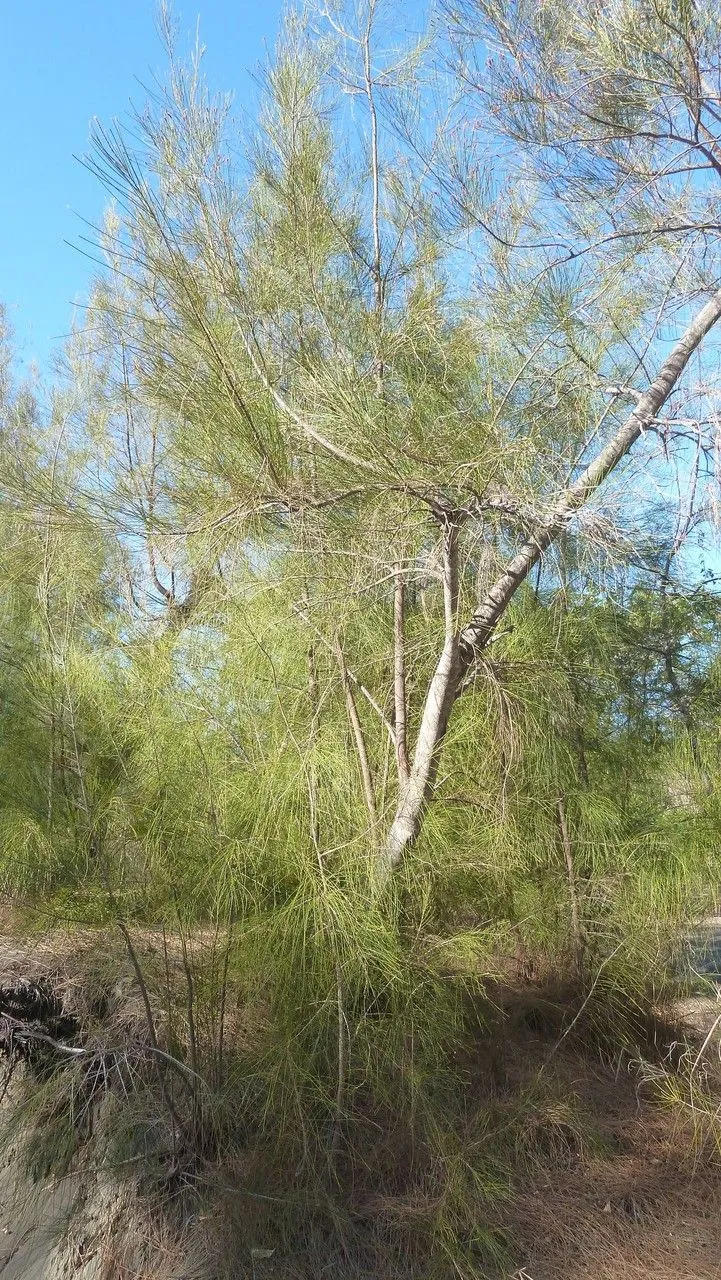
Author: Sieber ex Spreng.
Bibliography: Syst. Veg. 3: 803 (1826)
Year: 1826
Status: accepted
Rank: species
Genus: Casuarina
Vegetable: False
Observations: E. Australia
The Brazilian-oak, scientifically named Casuarina glauca, is an intriguing and versatile plant species native to Eastern Australia. This evergreen tree belongs to the Casuarinaceae family and has garnered attention for its distinctive appearance and a variety of uses. The Casuarina genus, which Brazilian-oak is a part of, is characterized by its tough, needle-like foliage that somewhat resembles that of pines, offering a unique aesthetic often sought after in landscaping.
Casuarina glauca typically thrives in a range of environmental conditions, showcasing its adaptability. The species is notable for its tolerance to salty and poor soils, making it highly suitable for coastal regions and areas where soil quality is a concern. The tree can grow in areas that are often inhospitable to other plant species, earning it a reputation for hardiness and resilience.
In addition to its robust nature, the Brazilian-oak plays an essential role in soil stabilization. Its extensive root system helps prevent erosion, making it a valuable plant in areas prone to this problem. Furthermore, the tree has a symbiotic relationship with nitrogen-fixing bacteria, which enables it to enrich the soil where it grows, thereby improving the conditions for surrounding flora.
From a practical standpoint, Casuarina glauca has multiple applications. It is widely used in agroforestry for windbreaks and shelterbelts due to its dense foliage and durable branches. The wood of the Brazilian-oak is also highly prized for its durability and workability, often utilized in furniture-making, fencing, and fuelwood.
Beyond its utilitarian uses, the Brazilian-oak is appreciated for its ornamental value. The unique, feathery foliage and its ability to thrive in diverse settings make it a popular choice for parks and gardens, adding both aesthetic beauty and ecological benefits to these spaces.
Central to understanding the historical context of Casuarina glauca is the contribution of Sieber ex Spreng., documented in the early 19th century, specifically in the Syst. Veg. 3: 803 (1826). The botanical classification and study during this period laid the groundwork for the more widely recognized utility and appreciation of this species today.
In summary, Casuarina glauca, or Brazilian-oak, is a resilient and multi-faceted species that plays a crucial role in both ecological stabilization and human utility. Its remarkable adaptability and range of applications make it a valuable plant in both natural and managed environments.
En: Brazilian-oak, Longleaf ironwood, Marsh she-oak, Scaly-bark beefwood, Swamp she-oak, Swamp-oak, Saltmarsh ironwood, Grey bull-oak, Grey she-oak, Gray sheoak, Grey Sheoak, Gray She-Oak, Brazilian beefwood, Suckering Australian-pine, Swamp oak, Waxy Casuarina, Scaly oak (Australia)
Ar: كازارينا غلوكية
Zh: 粗枝木麻黄
Fi: Suokasuariina
Fr: Filao glauque
Fa: بلوط مرداب
Pt: Casuarina
Taken May 18, 2022 by Marco (cc-by-sa)
© copyright of the Board of Trustees of the Royal Botanic Gardens, Kew.
Taken Sep 8, 2021 by Dieter Albrecht (cc-by-sa)
Taken May 18, 2022 by Marco (cc-by-sa)
Taken Jan 10, 2017 by Hugo SANTACREU (cc-by-sa)
Taken Sep 8, 2021 by Dieter Albrecht (cc-by-sa)
Taken Jan 10, 2017 by Hugo SANTACREU (cc-by-sa)
Taken Jan 13, 2022 by Yathish Rao (cc-by-sa)
Taken Jan 10, 2017 by Hugo SANTACREU (cc-by-sa)
Taken Aug 24, 2021 by Guillaume Lavigne (cc-by-sa)
Taken Jan 10, 2017 by Hugo SANTACREU (cc-by-sa)
Taken Jan 10, 2017 by Hugo SANTACREU (cc-by-sa)
Taken Jan 10, 2017 by Hugo SANTACREU (cc-by-sa)
Taken Jan 10, 2017 by Hugo SANTACREU (cc-by-sa)
Taken Jan 10, 2017 by Hugo SANTACREU (cc-by-sa)
Taken Jan 10, 2017 by Hugo SANTACREU (cc-by-sa)
Growth form: Single Stem
Growth habit: Tree
Growth rate: Rapid
Ph maximum: 7.5
Ph minimum: 6.5
Family: Myrtaceae Author: (F.Muell.) K.D.Hill & L.A.S.Johnson Bibliography: Telopea 6: 402 (1995) Year: 1995 Status:…
Family: Rubiaceae Author: Pierre ex A.Froehner Bibliography: Notizbl. Bot. Gart. Berlin-Dahlem 1: 237 (1897) Year:…
Family: Sapindaceae Author: Koidz. Bibliography: J. Coll. Sci. Imp. Univ. Tokyo 32(1): 38 (1911) Year:…
Family: Asteraceae Author: A.Gray Bibliography: Pacif. Railr. Rep.: 107 (1857) Year: 1857 Status: accepted Rank:…
Family: Fabaceae Author: Medik. Bibliography: Vorles. Churpfälz. Phys.-Ökon. Ges. 2: 398 (1787) Year: 1787 Status:…
Family: Aspleniaceae Author: (Cav.) Alston Bibliography: Bull. Misc. Inform. Kew 1932: 309 (1932) Year: 1932…